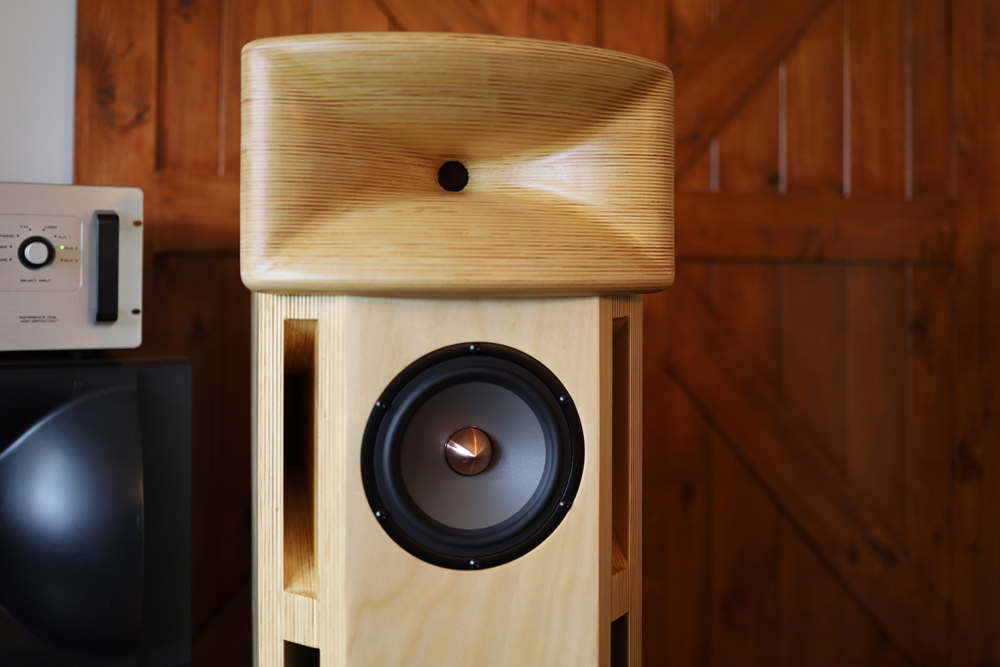In a market which could be seen as overloaded with participants, be it hi-fi, the automotive industry, fashion, whatever… how does a nascent enterprise signal a powerful intention, a running start entrance? One way is to eye-catch with a distinctive approach in juxtaposition to the established competition. Embracing that ideology, relatively new Australian loudspeaker manufacturer SpectraFlora has drawn market attention by entering the high-end space with the Celata 88 loudspeaker. The Celata 88 is a differentiation, an unconventional loudspeaker featuring a suite of technologies and design aspects seldom combined in the one product. Then, SpectraFlora ramps up the wow factor by posing an off-beat aesthetic, separating it from the mundane while opening opportunities for customisation. In this most challenging of product categories, is SpectraFlora a genuine disruptive innovator or has it not seen the forest for the trees?
From Bud to Flower
The Celata 88 loudspeaker came about in honour of designer Dr. Steve Van Sluyter’s love for high output, dynamically expressive horn loudspeakers from the 1960s and 1970s, such as the famous Japanese Onken designs. Van Sluyter similarly admires JBL classics of yore, such as the ‘cheeky’ (IYKYK) 4430 studio monitors which he uses as one of his references.
These personal preferences have influenced key ideologies behind the Celata 88 large standmount speakers which, at this stage, are SpectraFlora’s singular product. For starters, the high frequencies are handled by a Yuichi Arai-inspired, downscaled Arai horn-like waveguide which loads the 25 mm (1 inch) compression driver. The driver features a mineral loaded ketone polymer diaphragm and an “oversized” 52 mm voice coil. Compression drivers, especially in the context of a consumer loudspeaker system exhibit very high efficiency and tremendous levels of headroom. When matched to a conventional midrange driver, the compression tweeter needs hefty attenuation in the crossover design, resulting in further headroom extension, minimal diaphragm excursion, lower distortion, cooler operating parameters avoiding heat compression, and extended longevity. Sonically, the outcome is high dynamic potential and superb micro-detail rendition.
The compression driver is supported by SpectraFlora’s bespoke ‘Dynamic Waveguide’ which has been optimised for a controlled directivity pattern. Further dispersion tailoring is provided by the waveguide’s highly contoured and smoothly rounded edges. The waveguide’s architecture ends up providing 90 degrees of constant directivity in the horizontal plane, while it narrows the vertical directivity in order to minimise floor and ceiling reflections. Large portions of the SpectraFlora website are dedicated to detailing the concepts behind the Dynamic Waveguide – I suggest you visit for further insights.
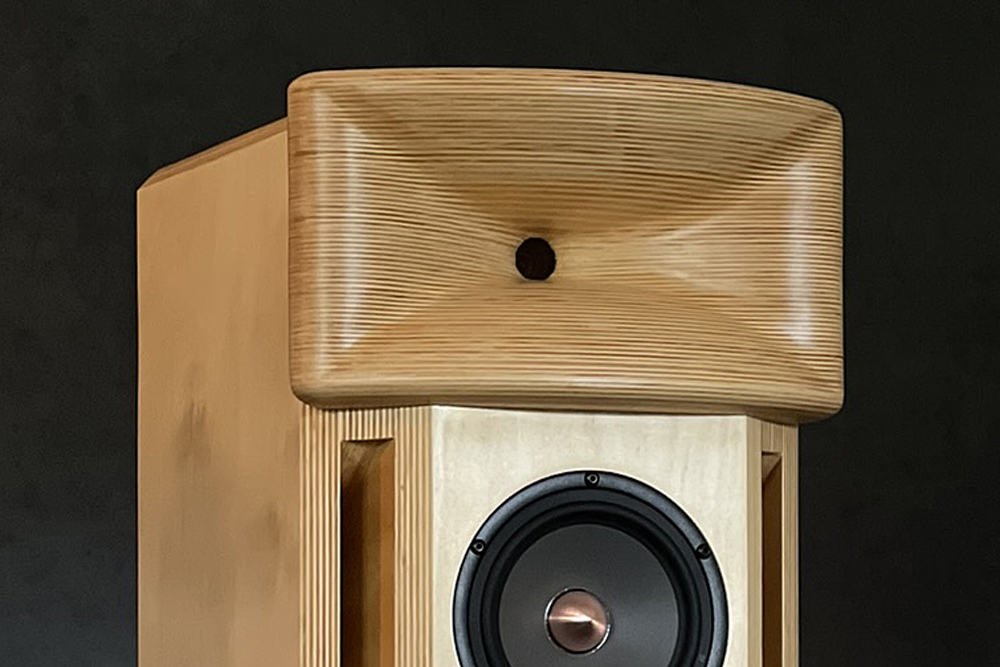
The mid-bass is handled by a 180 mm (7 inch) graphene-coated magnesium driver from SEAS. It features the signature copper ‘bullet’ phase plug in lieu of the more common dust cap. The driver is mounted within its own “densely packed and highly damped” sub-enclosure. The unit was selected as the most suitable for this application after a merry-go-round of over 20 similar drivers. The mid-bass transducer houses a large titanium voice coil former and a powerful magnet system featuring intermodulation distortion-reducing copper shorting rings. Again, in the Celata 88, the driver is crossed-over at a point designed to minimise excursion and reduce distortion. Sluyter states the mid-bass is “… pistonic through its entire range… and it is self-damping”.
Like seedlings buried beneath, Celata 88 conceals a pair of high power, slot-loaded, horizontally opposed 200 mm/8 inch woofers (or subwoofers as SpectraFlora refers to them) mounted within the enclosure. The bass drivers are mounted in tandem, one behind the other, in a push-pull configuration. The arrangement sees the front woofer firing back into the main cabinet via an internal chamber/channel, with its 18 mm plywood construction also providing extra bracing for stiffer cabinet panels. The subwoofers are supported via a vertical slot-vent reflex system on either side of the front baffle.
According to Van Sluyter, several low frequency reproduction methodologies were tested, such as transmission systems and a variety of reflex architectures. After extensive listening, Van Sluyter arrived at the push-pull configuration used in Celata 88, which he found produced the best, most nuanced and controlled option within this context.
Equal meticulous attention has been dedicated to the design of the Celata 88’s crossover network. In fact, Van Sluyter spent over 11 months in the listening and tuning stages which included evaluations between DSP-driven and passive variations, and even different binding post and interfacing cable types. In terms of the former, Van Sluyter found the final passive iteration sounded superior to the various DSP filters. Bi-amping is available via the twin copper binding posts on the rear panel. The rear panel also features a switch which, when activated, enhances the high frequencies (may be useful for over-damped acoustic environments), but Sluyter does not recommend its use unless absolutely necessary.
In addition, he also found that DC-biasing the capacitors with 18V provided noticeable improvements in performance, “… the topology of the 1300 Hz point is quasi-transient perfect”. To that end, unusually, if not uniquely, the Celata 88’s rear panel features two compartments housing a 9V battery each. The batteries bias the 42 (!) capacitors within the network which are made up of foil and film units for the Dynamic Waveguide tweeter, MKP metallised polypropylene bypassed by custom aluminium foil and film capacitors in the mid-bass, while the woofers feature electrolytics bypassed with MKP caps.
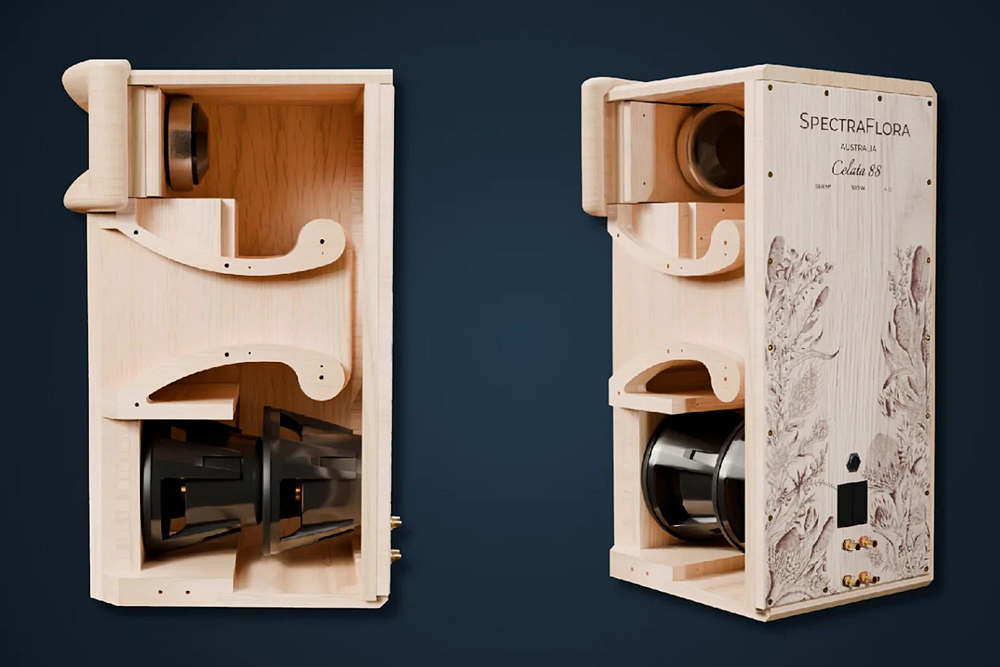
The Celata 88’s inert cabinet is assembled from Queensland hoop pine which is sustainably plantation grown and processed into solid plywood. The Dynamic Waveguide is constructed from the same timber type, or alternatively, Northern silky oak, or salvaged red ironbark timbers. The cabinet panels are CNC machined in Victoria. Ditto for the Dynamic Waveguide, albeit via a 7-axis CNC machine. SpectraFlora offers standard and custom finishes for both the main cabinet and the Dynamic Waveguide. Our review sample came in a black stained, satin polyurethane overcoated finish featuring diamond stitched leather on the side and top panels.
It's worth mentioning the Celata 88’s rear panel is a truly unique creation. It features a striking pyrographic etching of Australian Flora, wrapping about 70 percent of the panel’s surface, with the remainder taken up by the company logo, Celata 88 wattage and impedance ratings and a serial number.
SpectraFlora offers an optional short matching stand which can be customised with special finishes at an extra cost.
The Celata 88’s frequency response is quoted as spanning from 33 Hz (-3 dB) to 20 kHz, while nominal impedance is 4 ohms, and sensitivity is 86 dB (1 m/2.83V). The crossover points are set at 130 Hz and 1300 Hz. As mentioned above, the dual binding posts allow bi-amping which would present the opportunity to employ, for example, a sweet and tonally rich SET valve amplifier on the compression tweeter and mid-bass, and a powerful driver-controlling, high current solid-state or Class-D amplifier for the more demanding bass drivers.
I was keen to get some further insights, so I asked Van Sluyter about his early development ideas and the design philosophies behind the Celata 88 loudspeakers.
Most importantly, I wanted the design to be something everyone in a household could enjoy for many, many years. That meant exceptional sound quality and keeping the design compact, instead of huge floorstanders that dominate a room. But it had to compete with floorstanders for sound quality, especially bass extension…
The first thing I do in the morning, even before coffee, is turn on music. The last thing I do at night is turn the music off. Although I do a ton of critical listening, most of my listening isn’t sitting in a sweet spot, which is probably like most music lovers. I often listen with my partner and friends, so a major design goal was avoiding the narrow sweet spot effect by using a constant directivity waveguide, at least horizontally, so that timbre stays true off axis. Also, the reality for most people is that they’re not going to acoustically treat their lounge room, constant directivity helps with that, too.
For early development ideas, I had none; I tried to be as open minded as possible and tried countless, probably hundreds, of different configurations of many different drivers, different crossover topologies, active versus passive, everything I could think of that might be worth testing. I actually really like open baffle speakers. And horns. Transmission lines can be remarkable when done right.
I asked what are the qualities of the compression driver which appeal to Van Sluyter both in terms of engineering it into the Celata 88 and in terms of the sonic characteristics which he values.
I’ve never heard a tweeter that gripped me like a good compression driver driven horn can. At best, for a tweeter, I might think, well, that sounds nice. But a good horn can reproduce dynamics and intimacy in vocals so well that it’s totally engrossing and potentially a deeply emotional experience. I don’t mind horn colouration, but I know a lot of people do, so I tried pure waveguides driven by compression drivers. Their transparency and constant directivity are incredible… traditional horns do a better job of acoustically coupling the compression driver with the ambient air – it creates a more coherent wavefront than waveguides or especially direct radiating tweeters. I imagine that tweeters sort of flail at the air creating choppy, disordered wavefronts while horns propagate sound waves in an orderly, progressive way.
In any case, our Dynamic Waveguide design captures the best of both worlds, the dynamics of a horn from the vertical traditional horn profile with the transparency and constant directivity of a waveguide from the oblate spheroid horizontal profile. They’re two completely different schools of thought but their combination, which could be an industry first, works exceptionally well.
Lastly, compression drivers have so much headroom that it’s hardly worth calculating for home use. Many tweeters don’t have much headroom at all. I like loud music, and I wanted the Celata 88s to be able to go plenty loud with ease, so compression drivers were the obvious choice. Just not titanium diaphragms that I find fatiguing, although I don’t mind older JBL titanium compression drivers.
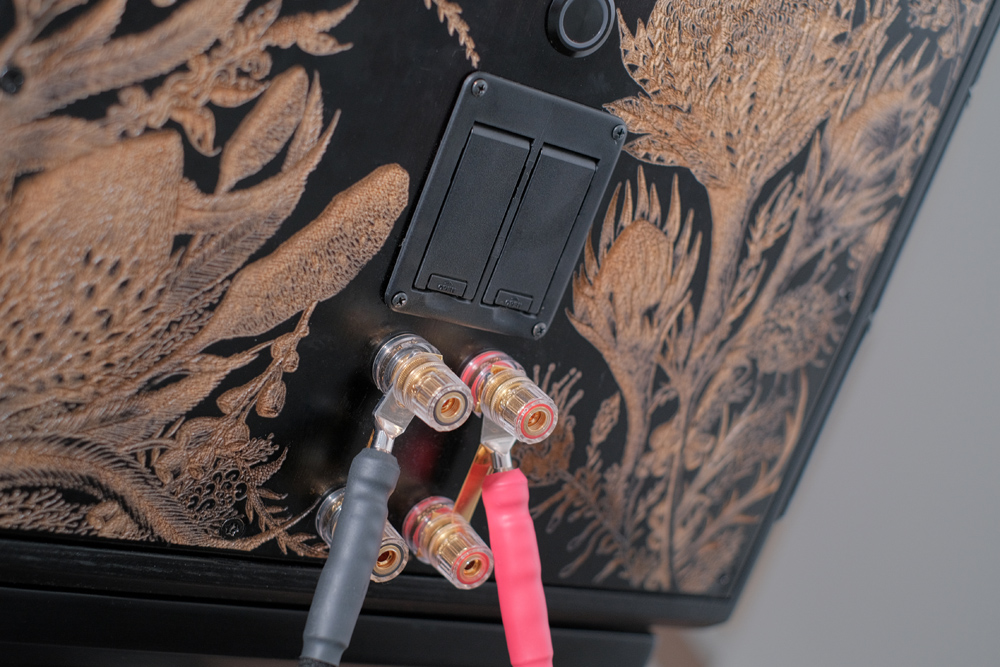
I asked about the Celata 88 being a distinctive loudspeaker with, literally, a couple of unseen design aspects in the dual woofers housed inside the cabinet.
In early tests we found that slot-loaded subwoofers sounded better than direct radiating ones – more crisp and more textured. Two subs firing into the same slot sounded better than that, especially when front to back. It’s an uncommon configuration and, when it has been done by others, the drivers are mounted perpendicular to the front baffle, which requires a wide front baffle.
For the Celata 88 I wanted to keep the front baffle narrow, so that’s how the drivers came to be front facing. The front driver fires into a short channel that loops back into the main cabinet interior. Instead of one central slot, we use one on either side, which looks like the side ports of the Onken speaker design from the 1960s that I think look good. Put the two bass reflex ports above the sub chamber ports, cut two big chamfers on either side, and the result is a narrow baffle. It’s worked really well. The subs sound outstanding and the narrow, chamfered front baffle reduces diffraction and pushes the baffle step into the crossover region, both of which help with soundstage and imaging from the mid. Also, all the internal structures to accommodate the subs and two bass reflex ports make the cabinet very stiff.
Starting a new loudspeaker brand, particularly one that features uncommon design aspects can be a difficult endeavour. I asked what were the main challenges in bringing the Celata 88 to market?
PCB design immediately comes to mind. It took three engineering firms to get the PCBs to a point where I was happy with them. The other challenge is fitting them in the Celata 88 cabinet – they barely fit and that’s with a couple inductors and high-wattage resistors mounted off the boards. There are 42 capacitors per cabinet. They’re big boards. One board takes up most of the cabinet back, the second takes up the cabinet top, and the third is mounted on the back of the mid-bass enclosure. All are mounted on 6 mm foam to mop up vibrations, which works both ways – the PCBs vibrate less and their weight (about 6 kg all up) damps panel vibrations.
Making waveguides from solid timber is challenging, too. Timber from Australian native species is difficult to dry, even in vacuum kilns, so big blocks of dry Aussie timber simply aren’t available because they don’t dry completely. Even recycled thick posts that might be decades old aren’t totally dry. If we were to use them and they dried after milling, they could deform and crack. That means we have to laminate several boards together for the waveguides. We CNC-rout the basic waveguide shape on a 3-axis CNC before laminating and moving to a 7-axis CNC. Each new lot of timber has to be 3-axis CNC routed differently, which requires additional CAD time and tool pathing.
Let’s Smell the Waratahs
Positioning the Celata 88s in my listening room saw them, once again, placed roughly within an inch or two of the location where I’ve found all speakers work optimally (with one or two exceptions). Van Sluyter delivered the speakers personally. I observed as he mindfully adjusted the speakers’ position and toe-in several times while evaluating the outcomes from the sweet spot. Once he was happy with the result in terms of placement, he went on his way, but not before thoughtfully soft cloth-polishing the speakers in order to present them at their best. Yeah, his dedication and passion for his creation was evident.
Over several weeks of listening, I discovered the many strengths of Celata 88, with the most immediately perceptible qualities being outstanding detail, a realistic vocal range, good dynamics and a solid and remarkably deep bass.
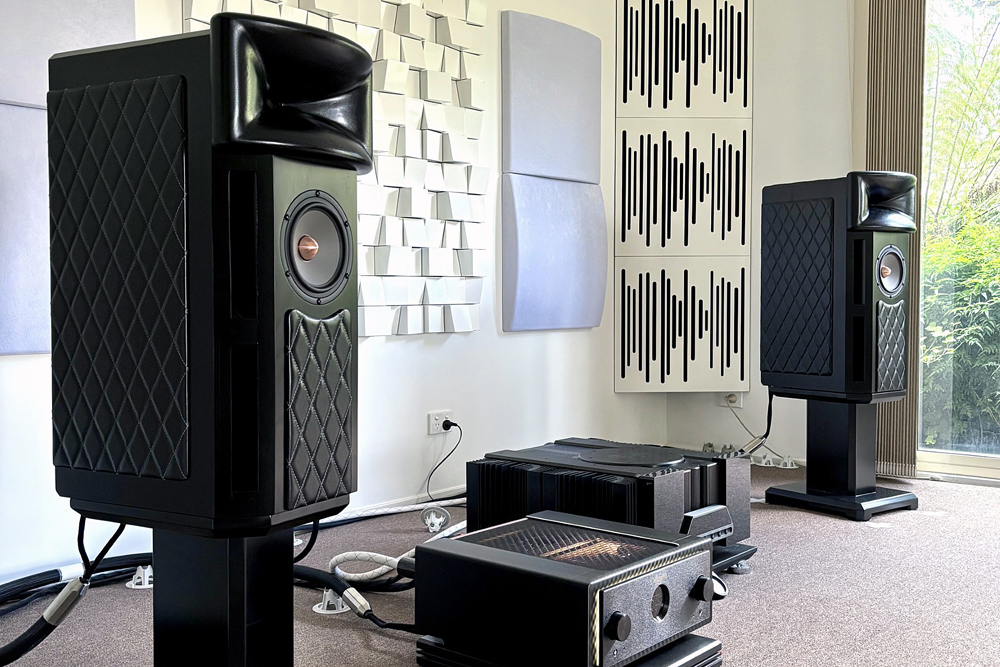
On Rokia Traoré’s “Yorodjan” from her outstanding Tchamantché album, Traoré’s beautiful voice was reproduced with subtlety and natural presence. The intro kick drum had appropriate weight and, in fact, surprisingly so for a speaker of the size (more to come on that). Traoré is a skilled guitarist too, not in a showy way, but rather in a way that always enhances the feel, or the vibe, of the song. Celata 88 rendered superb levels of detail in the plucked strings while being respectfully accurate with the guitar’s tonal qualities.
“Tea For Two” from Tsuyoshi Yamamoto Trio’s exceptional What a Wonderful World album features an intro filled with low level, nuanced detail from percussive piano, plucked bass, brushed snare and crystalline cymbal sounds. A component with inferior detail rendition capabilities may somewhat veil-over the intro’s finer complexities. Celata 88 presented all the subtleties and nuance with precision. On the title track the bowed bass and its friction with the strings was entirely believable in terms of the sheer information conveyed by the Celata 88s.
The simple artistry of “Deadweight on Velveteen” on José Gonzaléz’s Veneer album can be mesmerising. The track’s early strums are hard-hitting via Celata 88, with the strikes being not just a slamming shock but also being resolved enough to expose the multiple strings that make up the chord. Then when Gonzaléz sings he’s placed in sharp focus in a wide and fairly deep soundstage. His voice sounds natural and in-the-room present. The next track, “All You Deliver” is communicated with quiet beauty and stunning guitar detail, with notes decaying with excellent decay. Gonzalez gently taps the body of the guitar towards the end of the track, and Celata 88 clearly and realistically conveyed the sound of the void, the wooden hollowness of the instrument as it’s being struck.
As I mentioned above, the Celata 88 is capable of producing deep and powerful low frequencies. Those dual 200 mm woofers are solid units and when fed demanding music, they offer tight and detailed bass. Victor Wooten’s “Cambo” from Palmystery showed both the acrobatic dexterity of Wooten and the Celata 88s fast tracking of the bass mayhem. The track also features hectic drumming, vocals, keyboards and other instruments. The speakers did not confuse the variety of tonal signatures while also separating the instrumental streams in a way which did not disrupt the homogeny of the music.
Throughout my audition across a wide variety of torture tracks, the bass remained agile and completely responsive to the transient attack of the low frequencies. And that applied to bass heavy albums with the beauty and artistry of Adam Ben Ezra (Can’t Stop Running), to the dexterity and speed of Zander Zon (Sonorous), to the monstrous caricature assaults of Bass Mekanik (King of Bass).
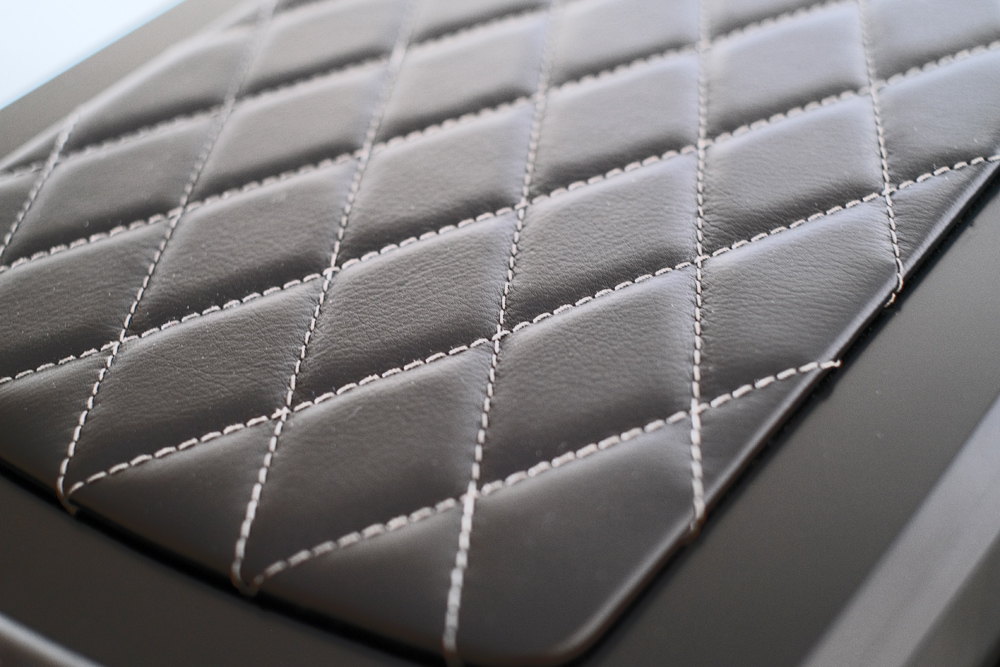
Evgeny Kissin’s piano on Mozart: Piano Concertos № 20 and 27 with the Kremerata Baltica Chamber Orchestra on a Warner Classics release sounded both majestically large, in terms of its venue rendition, and intimate through Kissin’s solo sections. Again, the piano exhibits very good tonal precision and dynamic expression. In the Allegro sections there were appropriate impressions of the orchestra’s size and power.
Can the Celata 88s rock? Hell yeah. Just spin raw power rock such as Sasquatch’s “Rational Woman” where the track escalates then explodes, or the alternative protest of Rage Against The Machine’s “Take The Power Back” where the early kick drum and bass lines are examples of masterful recording and mastering. Celata 88 keeps up with it all while generously offering concussive slam, thumping power and rhythmic speed.
Conclusion
The Celata 88 loudspeakers are the product of an inspired designer who distances himself from the plain run-of-the mill. Dr. Steve Van Sluyter poses the question: Do you accept convention, or do you welcome individuality… an alternative viewpoint?
In his creation, Van Sluyter has taken beloved qualities from OG classics and reimagined the concepts. He then incorporated the ideas in a room friendly architecture which performs beyond its physical proportions. And he shows it all off in a form which is remarkably distinctive.

While with ideology in mind, the Celata 88 can be seen as an homage to vintage designs, SpectraFlora is also cognisant of the demands of modern reproduction and listener tastes. It caters to that by incorporating modern, high quality drivers, a mix of bespoke and premium crossover parts, a meticulous design process, and extensive sessions of scrupulous voicing. What’s more, SpectraFlora’s correlation with nature sees the company choosing to employ sustainable plantation-sourced materials and veneers throughout Celata 88’s design.
Yes, given all that Celata 88 delivers, if the market weather is fair, budding loudspeaker maker SpectraFlora will continue to grow and, indeed, bloom.
… Edgar Kramer
This email address is being protected from spambots. You need JavaScript enabled to view it.
Associated Equipment
- Speakers — Wilson Audio Alexia V, Axis Loudspeakers VoiceBox S (nearfield monitor), Vermouth Audio Little Luccas Mk.II Limited Edition, Atacama stands
- Amplifier — Gryphon Audio Antileon EVO
- Preamplifier — Supratek Cortese, Totaldac d1-triunity (periodically, direct to amplifier)
- Sources — Digital:432 EVO Aeon Mk.3 Reference Music Server/Roon Core, Yamaha CD-S2100 transport, Totaldac d1-triunity DAC. Analogue: Transrotor Crescendo with Konstant Studio controller, Reed 1X Tonearm with upgraded internal wiring, Shelter Harmony cartridge, The Funk Firm Houdini cartridge decoupler, Supratek Cortese & REDGUM Audio RGPH2 phono stages
- Processor — DEQX PreMate (part of arsenal/casual use)
- Cables — VYDA Laboratories Orion Silver Reference HFC IC and speaker cables, PSC Audio custom design XLR, Vermouth Audio Reference loom,Tubulus Concentus USB
- Audio Rack — SGR Audio Statement MODEL V, Aspire Audio Belgravia amplifier platform (customised for Gryphon Audio Antileon EVO), Stereotech Aluminar Dark 3-tier rack
- Acoustic Treatment — Vicoustic Multifuser Wood, Wavewood Ultra, Cinema Round Premium and Super Bass Extreme
- Miscellaneous — Silent Angel Bonn N8 Pro network switch, GigaWatt PF-1 EVO power strip, Les Davis Audio Viscoelastic CLD discs, Voodoo Cable Iso-Pods, Bocchino Audio Mecado, VRC Vinyl Record Cleaning systemplus miscellaneous accessories
SpectraFlora Celata 88 Loudspeakers
Price: AU$35,000 (Stands AU$1000) in standard Natural finish
Australian Warranty: Three Years on drivers, Lifetime on cabinet, waveguide & stands
Australian Distributor: SpectraFlora Direct
+61 (0) 412 653 966
www.spectraflora.com
SpectraFlora
PO Box 6
Inverleigh, VIC
Australia
+61 (0) 412 653 966
www.spectraflora.com
